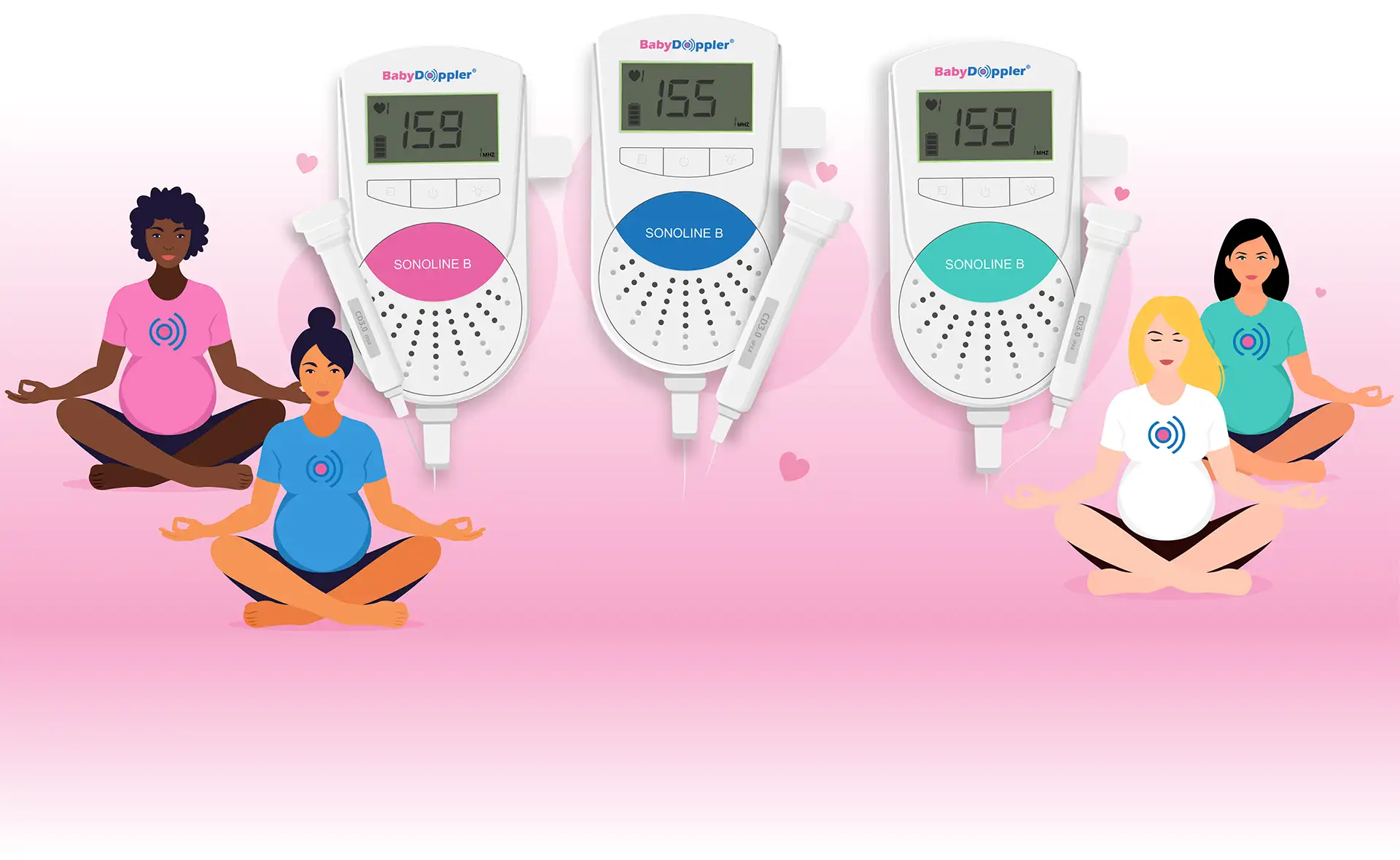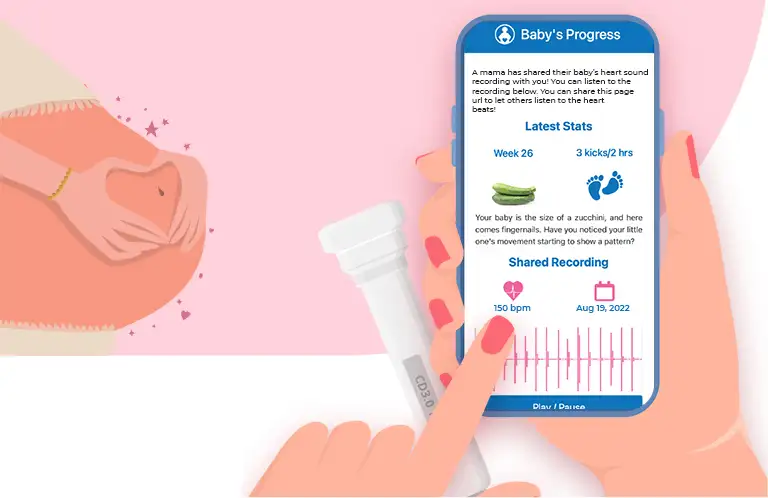Shopping Cart
items in cart
Hide Cart
Show Cart
Checkout using your account
Checkout as a new customer
Creating an account has many benefits:
- See order and shipping status
- Track order history
- Check out faster

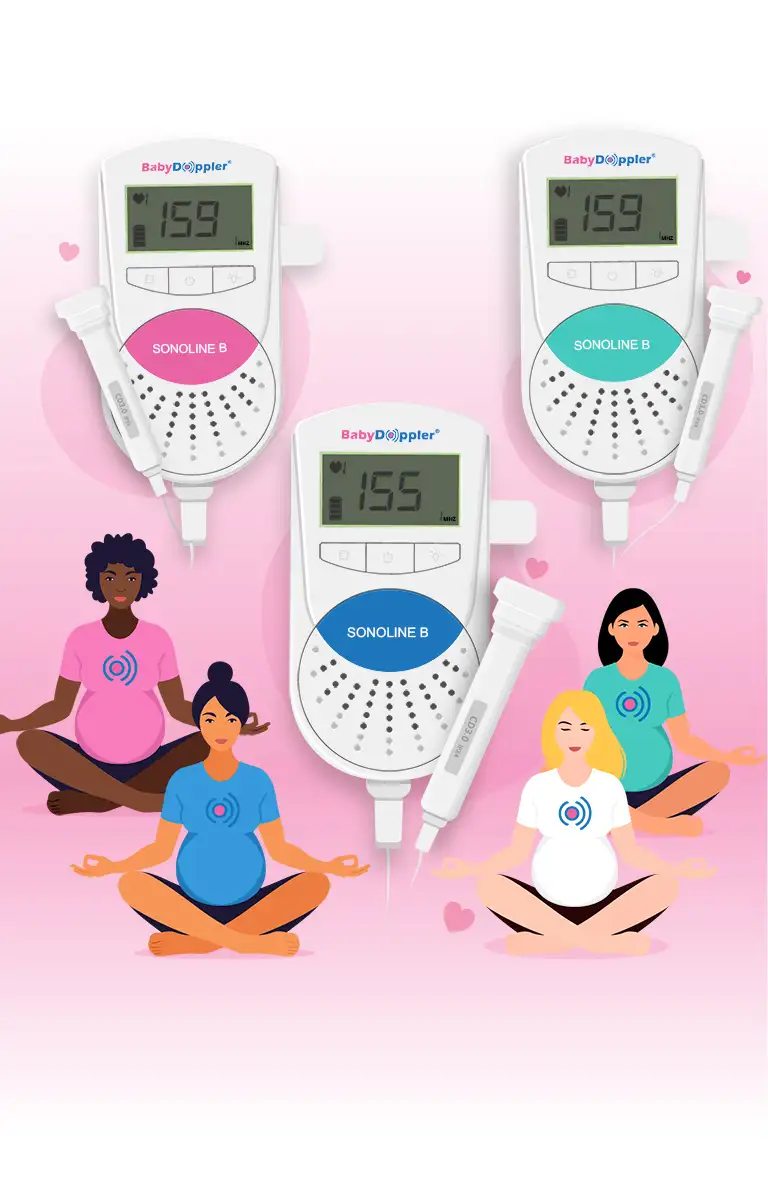
We know you’re excited to use our #1 Fetal Doppler.
Select one of the buttons below to access the step-by-step guides to get the best experience with Baby Doppler.
How to use
Baby Doppler "Sonoline B"
Baby Heartbeat Tracker
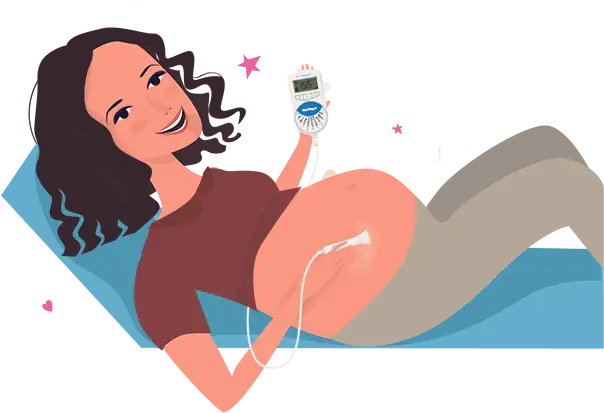
WHAT YOU WILL NEED

Sonoline B Heartbeat Monitor

Sound Enhancing Gel, Doppler Probe and 2 x AA Batteries (comes with the Heartbeat Monitor)

A comfortable place to lie flat

Tissues or towel to wipe off the gel
Optional: Download the free Baby Doppler App to share your experience
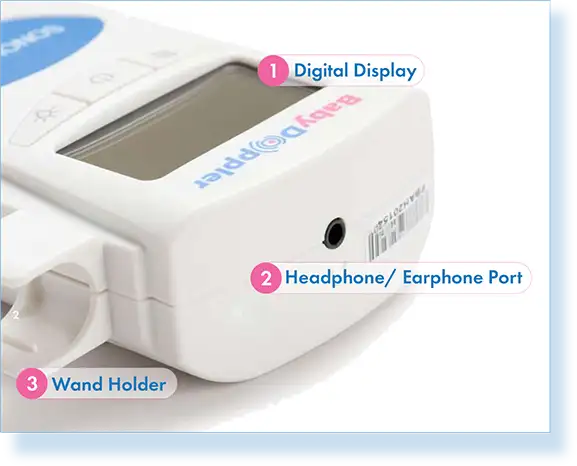
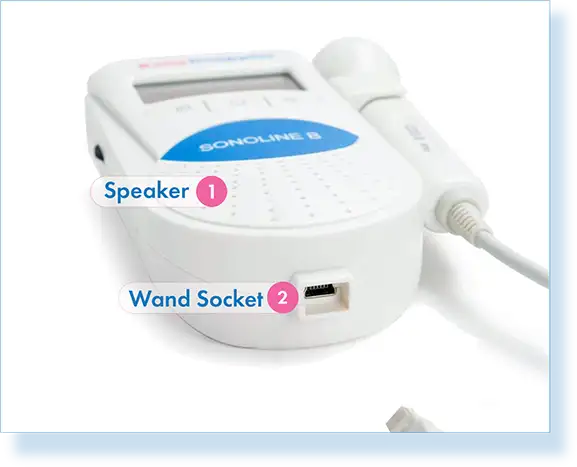
Best time to use Baby Doppler

30 minutes after waking up

60 minutes after eating

30 minutes before bedtime
Step 1
- Place the 2 x AA Batteries inside the Sonoline B - #Baby Heartbeat Tracker.
- Connect the doppler probe wire to the main device.
- Lie down comfortably with your back down on a flat surface.
- Expose your abdomen like you would during a regular ultrasound.
- Using the Baby Doppler while you have a full bladder can #make the heart-beat easier to hear.
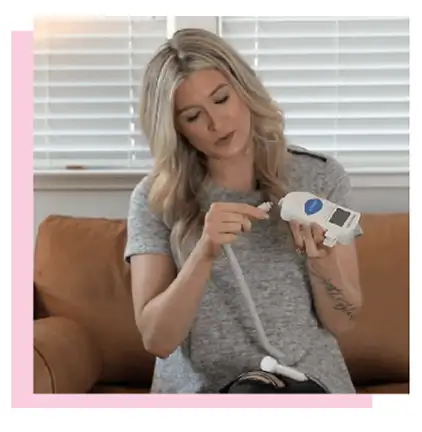
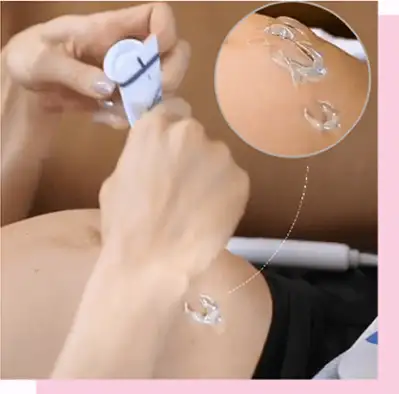
Step 2
- Switch on the device from the power button located right #on the center of the doppler.
- Use the doppler probe to move around your lower belly until you#find a strong sound of your babyʼs heartbeat.
- Since the gel will reduce static, use a generous amount.
Step 3
- Starting from your pubic bone, gently glide the probe upwards towards your belly button. Slowly rock the probe, covering every#part of your stomach so that you find the heartbeat.
- If after a few minutes you cannot find your baby, shut the #device off and try another time. You may need to wait for the #baby to grow bigger or switch posi-tions.
- You can read the heart rate at the display monitor with the #heartbeat sound.
- You can increase/ decrease the volume from the volume #controller given on side of Heartbeat Tracker
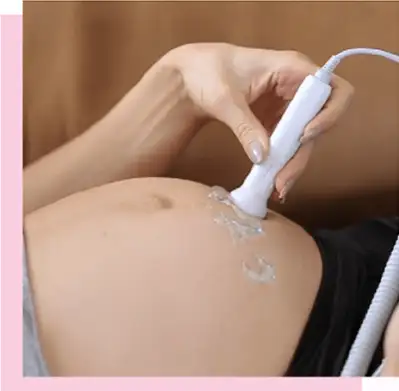
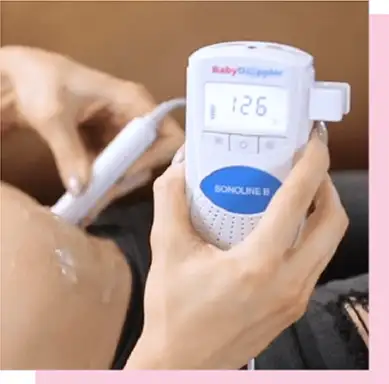
Step 4
- After you've finished, clean off the probe to avoid any build-up.
- You may choose to wipe it with 70% ethanol and then let it #air dry or simply wipe it with a clean, dry cloth.
- Since the gel will reduce static, use a generous amount.
HOW TO USE
BABY DOPPLER"
APP
WHAT YOU WILL NEED TO DO BEFORE USING THE APP

Download the Baby Doppler app in the Apple or Google Play store.

Create an account.

Customize your profile with details like your birthday and health information.

Create a baby profile. Fill out details such as your babyʼs due date, gender and name.
HOW TO USE THE BABY DOPPLER APP TO COUNT KICKS
- Open the app.
- Tap “Kick Counter” at the bottom of the screen.
- Sit or lay down on your side and click start.
- Let the kick counter run. Youʼll get a notification when 2 hours is up. During this time, choose a relaxing activity that allows you to pay attention to kicks. Examples include watching TV, reading, calming hobbies, etc.
- Press and hold the countdown notification to “Add 1 Kick” every time you feel a movement. Movements include kicks, rolls, swishes, flutter, jabs, pushes, etc. Hiccups do not count.
- Continue adding kicks until you reach 10 kicks. At this time, youʼll see your recorded amount of time to reach that count.
- If it takes you 2 hours to count movements, youʼll see that the session has completed with your recorded number of movements.
- Take time to reflect on your recording each session. If you re 28 weeks or more, have you met the guideline of 10 kicks within 2 hours or less?
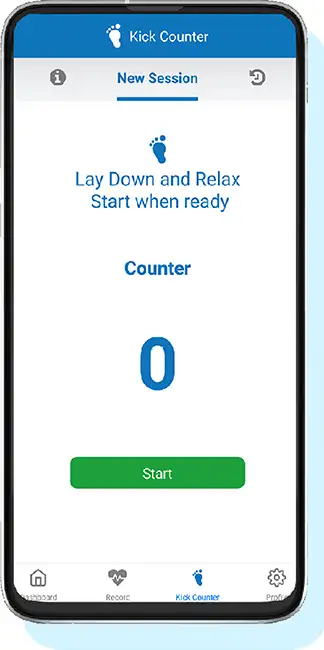
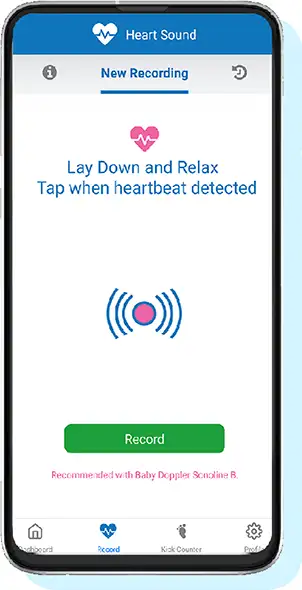
HOW TO USE THE BABY DOPPLER APP TO RECORD FETAL HEARTBEAT
- Open the Baby Doppler App.
- Tap “New Recording” at the top of the screen.
- Apply ultrasound gel to your lower belly. Turn the device on. Place the probe in the gel. Use a rocking motion to glide the probe toward your pubic bone and around until you detect a heartbeat.
- Tap “Tap to Record” when you detect the heartbeat.
- Listen and evaluate your sound recording. If itʼs good, tap “Submit.” If you want to try again, click “Re-Record” and follow the steps again for a clearer ver-sion.
- Tap the “Record” icon at the bottom of the screen to view a list of your past re-cordings.
HOW TO USE THE BABY DOPPLER APP TO SHARE HEARTBEAT
- After youʼve recorded your babyʼs heartbeat, click “Share Progress with Family” at the top (you can share the heartbeat with your doctor/midwife or family/friends).
- Save to your files or use the icons for other sharing and copying options.
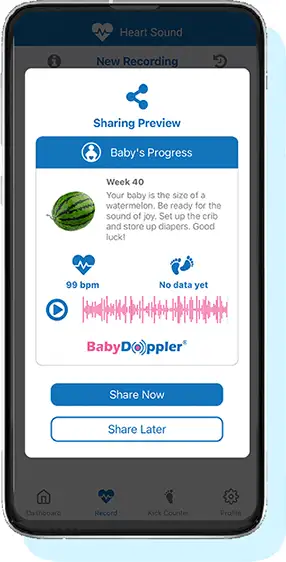
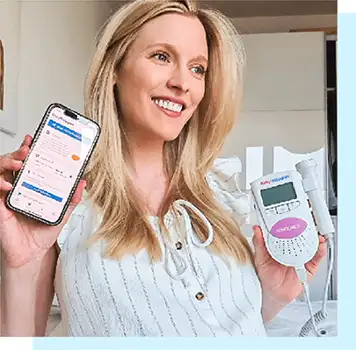
HOW TO SHARE HEARTBEAT VIDEO ON SOCIAL MEDIA
- Use the Baby Doppler app to make your recording and save it to your device.
- Download and open a video editing app such as Magisto Video Editor and Maker.
- Upload pictures of your babyʼs sonogram, pregnancy photoshoot and any other visuals.
- Add text indicating your babyʼs due date. You can also add titles and write a message for friends, family and followers.
- Upload your babyʼs heartbeat recording and add it to your video.
- Save your video.
- Upload video to Instagram, Facebook, TikTok, etc. You can also email it if youʼd prefer to keep it private.
Fetal Doppler Instruction
FAQ

Congrats, you've given yourself the gift of hearing your baby's heartbeat from home!
With a fetal doppler, you don't need to wait until your next appointment - you can feel connected to your baby at your convenience.
Here's everything you need to know about your Baby Doppler.
What is a Fetal Doppler?
Fetal dopplers, AKA fetal heartbeat monitors, are devices that allow you to listen to and monitor your baby's heartbeat. It works similar to an ultrasound machine at a doctor's office or hospital. You lay down, rub ultrasound gel on your stomach, and use a probe to detect a beat.
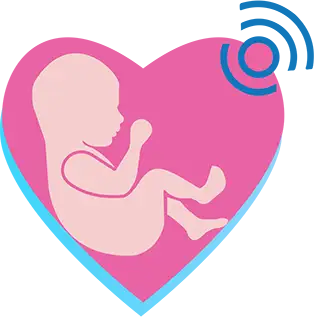
The key is finding the right spot and honing in on the regular heartbeat noise form your baby.
Once you do, you'll be able to hear it through the device speakers. The fetal heart rate (FHR) will also be displayed on the screen.
Supplies: What Do I Need to Use My Fetal Doppler?
Here's what you'll need to get started.

Fetal Doppler:
You can get your fetal doppler here.

Ultrasound Gel:
We also recommend stocking up on a full bottle so you'll have plenty when you need. If you're in a pinch, here's 8 Ultrasound Gel.
You'll need something that makes your probeglide across your belly and minimize any sound that may com from the friction caused by the probe against your skin. Baby Doppler devices come with a free 60ml tube of gel.
Alternatives. Keep in mind that ultrasound gel will always produce the best results for the clearest heartbeat.

Batteries:
To use your device, you'll need 2xAA batteries.The Baby Doppler brand comes with batteries included,which should last at least 10 hours.

Paper Towels:
After you are finished using your doppler, you'll want to wipe the gel off without having to stand up, creating a mess. Have some paper towels or tissue by your side.

Place to Lay Down:
Fetal dopplers work best when you're in a relaxed position. Recline or lay back, propping yourself up with a few pillows.

Baby Doppler App:
If you want to record your baby's heartbeat so you can hear it later, download the Baby Doppler app so you have it ready.
Step-by-Step: How Do | Use My Fetal Doppler?
Using a fetal doppler looks similar to having an ulirasound.
- Find a comfortable place to sit down or recline.
- Pull your shirt up, exposing your abdomen. Apply a generous glob of ultrasound gel to your lower belly
- Place the fetal doppler probe in the ullrasound gel. Turn the device on.
- Use a rocking motion to gently glide the probe. Start a! your lower pubic bone and rock upward. Try to cover each area to ensure you find your baby.
- Detect your baby's heartbeat and ensure it's the right noise. Don't get it confused with your heartbeat or other bodily noises. The two tell-tale signs that you've found a fetal hearibeot are that i's ot least 120 beals per minute (BPM) and it sounds similar to galloping horses. For more lips on finding the right noise, read the next section.
- Can't find the noise? Don't panic or overuse the device. You might need to wait until your baby grows bigger or switches positions.
- Once you've detected the heartbeat, you can use the Baby Doppler app to record the sound. (Read: How To Use Baby Doppler App to Record Baby's Hearibeat!)
- When you'e finished, wipe off he probe using paper towel. You can also wipe i using 70% ethanol and leling it air dry.
Is This the Right Noise? Finding the CORRECT Sound
The key to properly using @ fetal doppler is discerning the correct noise. You don’t want to confuse it with your heoribeat or the sound of placenta.
Here are a few tips:

BPM
The first sign you've found the right noise is hat the screen displays 120-180 BPM. An adult heartbeat will usually be around 60-100 BPM.

Galloping Horses
The most commonly used comparison to describe a'fetal heartbeat is he sound of galloping horses. In contrast, the sound of movement or your placenta is offen described as whooshing’ or blowing trees.

Listen to Comparison Videos
To learn what it should sound lke, watch others who've successfully detected a fetal heartbeat. Compare this to what you hear.

Audio Comparison App
For a handy go-to guide, we recommend using the audio references provided in the Baby Doppler app. Tap “Record,” then tap the "i" icon at the top of the screen. Select “View Audio Examples.” You can hear the sound in three different scenarios: clear, with mom’s blood flow, and with movement noise.
Tips: How Can | Easily Find My Baby’s Heartbeat?
Finding and discerning your baby’s heartbeat becomes easier over time. That's because you'll get better with practice and your baby will get bigger, making him or her easier to find.
There are a few things you can try to increase your chances of success:

Full Bladder
Many people find it easiest lo detect a heartbeat when they have a full bladder. This helps push your uterus up from your pelvic cavity, making detection quicker and clearer.

Mornings
Some people also find it easiest to detect a heartbeat in the morning. One reason could be that it's typically when you're the least bloated. You might also have a full bladder from resting overnight.

Study the Sounds
Are you sure you aren't detecting the hearlbeat? We recommend that everyone first listens to a fetal heartbeat. That way, you'll know what you're looking for.

Clean
If you don't clean the probe, gel build-up can create static, making it harder to hear.

Generous with Gel
Stocking up on ultrasound gel ensures you're not stingy with it. Using less gel could mean more static. Using too much may also cause sound issues.

Take Breaks
If you can't hear a heartbeat, try again later or the next day. You might not easily find a heartbeat each time and that's okay. If the device is giving you anxiety, it's a good idea to put it away until your baby grows and can be easily and predictably detected.
What If I'm Having Twins?
If you're having twins, yon con expect to hear two different heartbeats as you chill the probe. However, hearing two “heartbeats” isn't always a sign of twins. You might just be picking up the some noise in two places.
When Should I Call My Healthcare Provider?
As we mentioned above, there's mony reasons a fetal doppler might not work— many of which don't involve the health of your baby. The main question lo ask yourself is if he lack of detection is accompanied by a lack of movement, Are there any other signals something is wrong? For example, if you feel fewer than 10 kicks in 2 hours post 28 weeks, that's more evidence for concern.
If you've waited or feel there's something wrong for any reason, don't hesitate and call your doctor or midwife.
If you detect a suspected abnormality in your baby’s heartbeat, you can record it using the Baby Doppler app and send it to your doctor for further examination. The doppler can also be used alongside a doctor during telehealth video appoiniments.
Remember that fetal dopplers can only be used by trained professionals to diagnose issues. They do not replace prenatal appointments or advice.
How Can I Clean My Fetal Doppler?
After every session, wipe off the ultrasound gel using a paper towel, tissue or dry cloth. It's also a good idea to fully clean it. This helps prevent build-up, which could cause static. To do this, you can wipe it with 70% ethanol and let it air dry.
Don't submerge the device or probe in water. Don't use cleaning chemicals.
How Can I Share My Baby's Heartbeat?
When you hear the magic, you'll probably want to share it with the world. The Baby Doppler app allows you to record your baby's heartbeat. You can save and email it, share it on social media, and more.
How Else Can I Monitor My Pregnancy?
To make the most out of your fetal doppler, download the Baby Doppler app. Along with giving you the option to record and track your baby's heartbeat, there's also a kick counter.
Counting your baby's kicks is important starting at week 28. Keeping this habit helps you recognize if something is wrong. Seeing a list of your baby's number of movements can help you track how your baby is growing.

